 Open Access
Open Access
ARTICLE
An Efficient Approach for Solving One-Dimensional Fractional Heat Conduction Equation
1
Department of Mathematics, Al Zaytoonah University of Jordan, Amman, 11733, Jordan
2
Nonlinear Dynamics Research Center (NDRC), Ajman University, Ajman, United Arab Emirates
3
Department of Mathematics, Al al-Bayt University, Mafraq, 130095, Jordan
4
Department of Mathematics, Irbid National University, Irbid, 2600, Jordan
5
Department of Mathematics, The University of Jordan, Amman, 11942, Jordan
* Corresponding Authors: Iqbal M. Batiha. Email: ; Shaher Momani. Email:
(This article belongs to the Special Issue: Computational and Numerical Advances in Heat Transfer: Models and Methods I)
Frontiers in Heat and Mass Transfer 2023, 21, 487-504. https://doi.org/10.32604/fhmt.2023.045021
Received 15 August 2023; Accepted 25 September 2023; Issue published 30 November 2023
Abstract
Several researchers have dealt with the one-dimensional fractional heat conduction equation in the last decades, but as far as we know, no one has investigated such a problem from the perspective of developing suitable fractionalorder methods. This has actually motivated us to address this problem by the way of establishing a proper fractional approach that involves employing a combination of a novel fractional difference formula to approximate the Caputo differentiator of order α coupled with the modified three-point fractional formula to approximate the Caputo differentiator of order 2α, where 0 < α ≤ 1. As a result, the fractional heat conduction equation is then reexpressed numerically using the aforementioned formulas, and by dividing the considered mesh into multiple nodes, a system is generated and algebraically solved with the aid of MATLAB. This would allow us to obtain the desired approximate solution for the problem at hand.Keywords
The heat equation of one-dimension, initially investigated by Fourier in the 19th century, has remained a fundamental model for extensively studying linear and nonlinear parabolic partial differential equations (PDEs). There are various views of this exemplar, some of which have not yet been extended to space-variable case of multidimensions [1]. Notably, it covers discussions on free boundary value problems (BVPs) like the inverse problems, one-phase Stefan problem, and certain categories of ill-posed problems. The approach of implementing certain analytic tools to study this popular and widely applicable PDE makes it a worthwhile manual that aims to provide the basics of PDEs in simpler yet relevant situations, such as the one-dimensional heat equation [2].
In the last decades, there were several researchers who had studied the one-dimensional fractional heat conduction equation, but as far as we know, no one has investigated such a problem from the perspective of developing suitable fractional-order methods. This has actually motivated us to address this problem by the way of establishing a proper fractional approach that involves employing a combination of a novel fractional difference formula to approximate the Caputo differentiator of order
Fractional calculus and fractional partial differential equations (FPDEs) have garnered growing consideration across multiple scientific fields for the past decades [11–13]. Replacing the derivative of integer-order in energy conservation models, momentum or standard mass with a fractional-order derivative enables up-scaling of local variations that are often challenging to exclusively measure [14,15]. This leads to non-local FPDEs with temporally or spatially averaged parameters, offering an efficient means to capture more rich dynamics of the considered problem [16–18]. Fractional differential equations (FDEs) commonly describe the relationship between an unknown function and its derivatives, typically involving fractional derivatives of a single independent variable. This type of equations can be further categorized into fractional initial value problems (FIVPs) and fractional boundary value problems (FBVPs) [19]. Analytical solutions for practical problems stemming from limited FIVPEs and FBVPs are proposed in conjunction with specific analytical methods. Homotopy perturbation technique, Adomian decomposition method and variational iteration method are, for instance, some of these methods [20]. In the same regards, various numerical approaches are regarded immensely helpful tools for promptly finding solutions for numerous linear and nonlinear FIVPEs and FBVPs problems, especially when combined them with code producing. Many investigators have advanced numerous numerical methods for solving such problems. Galerkin finite element approach, finite difference method, collocation method, spectral method, Gegenbauer-based Nyström method, fractional Euler’s method, modified fractional Euler method, improved modified fractional Euler method and wavelet method are, for instance, some of these numerical methods, see [20–26]. The problem here is to find a numerical solution of the one-dimensional fractional heat conduction equation. From a mathematical point of view, this is a moving boundary problem and it is difficult to obtain its exact solutions. For fractional moving boundary problems, some researchers attempted to present proper analytical solutions for different types of those problems, see [27] and the references therein.
The rest of this article is arranged as follows: In the next section, we recall the most important preliminaries connected with the fractional calculus. In Section 3, we first establish a novel fractional difference formula to approximate the Caputo differentiator of order
In this section, we review a few primary definitions and important preliminary concepts related to fractional calculus. These key concepts serve as a foundation for our principal results that will be presented later.
Definition 2.1. [12,28] The Riemann–Liouville integrator in its fractional case of a function
where
In the subsequent lines, we review specific features of Riemann–Liouville integrator for fulfillment:
Definition 2.2. [12,28] The Caputo differentiator of a function
where
Some of Caputo differentiator properties are outlined in the following content [12,28]:
Along the same lines, we remember in what follows some further characteristics associated with the composition Riemann–Liouville integrator with Caputo differentiator [12,28]:
and
where
Definition 2.3. [12,28] The Caputo differentiator could be described in terms of the Riemann–Liouville integrator of a function
where
In the following lines, we remind one significant result that plays a crucial role in deriving the principal findings of this work, the generalized Taylor’s theorem [12].
Theorem 2.1. [12] (Generalized Taylor’s Theorem) Assume that
where
In this part, we intend to introduce the major findings of this work. To do so, we first establish a highly significant result concerning the Caputo fractional differentiator.
Lemma 3.1. Let
where
Proof. Based on Theorem 2.1, one might expand
for some unknown value of
or
This implies
which immediately yields
or approximately as
with truncation error
Recently, an important result was obtained in [29] in order to approximate the Caputo differentiator. The derivation of this result was inspired by a similar approach used in [30], and it was termed the modified three-point fractional formula. However, we recall this result below for completeness.
Theorem 3.1. [29] Let
where
As a result of Theorem 3.1 that concerns with the modified three-point fractional formula for approximating Caputo differentiator
Corollary 3.1. Let
where
Proof. This result is immediately yielded by just operating the Caputo differentiator (2.2) to the fractional formula (21) once again, and by substituting
From now on, we aim to investigate the so-called one-dimensional heat conduction equation. The classical form of this kind of equations can be given by
with boundary conditions
and with initial condition
In fact, the above problem can be expressed in its corresponding fractional-order case as follows:
with boundary conditions
and with initial condition
To solve problem (23), we will utilize the fractional difference formula for approximating the Caputo differentiator, as presented in Theorem 3.1, in conjunction with the modified three-points fractional formula for approximating Caputo differentiator of order
for
This equality can be written in the form
where
Now, with the use of (26), we can infer the following states
where
for
where
and
The system described above can be solved algebraically using MATLAB to obtain the desired approximate solution for the intended problem as MATLAB provides powerful numerical and computational tools that are well-suited for solving systems of equations and obtaining approximate solutions efficiently and accurately.
In this part, we intend to verify the effectiveness of our proposed approach. Figures and tables are utilized to display and compare the gained findings.
Example 4.1. Consider the following fractional heat conduction equation:
with boundary conditions
and with initial condition
It should be noted that the analytical solution of problem (27) when
In particular, the above analytical solution (28) can be plot as shown in Fig. 1. In this connection, when we apply on the proposed numerical approach discussed in Section 3 with letting
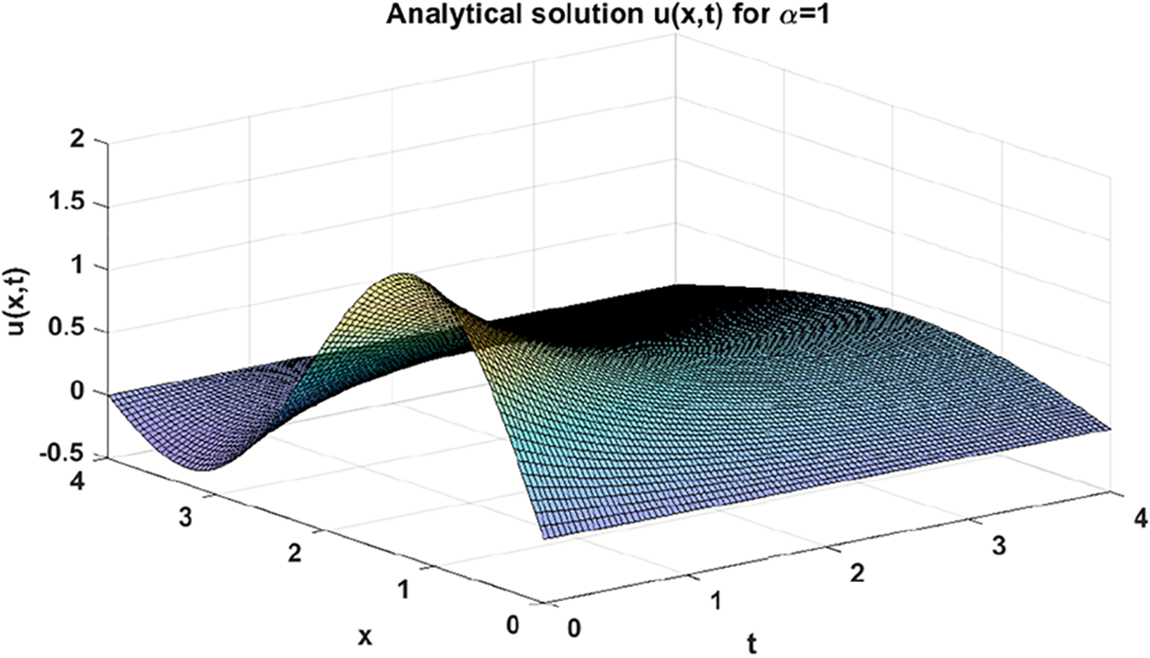
Figure 1: Analytical solution
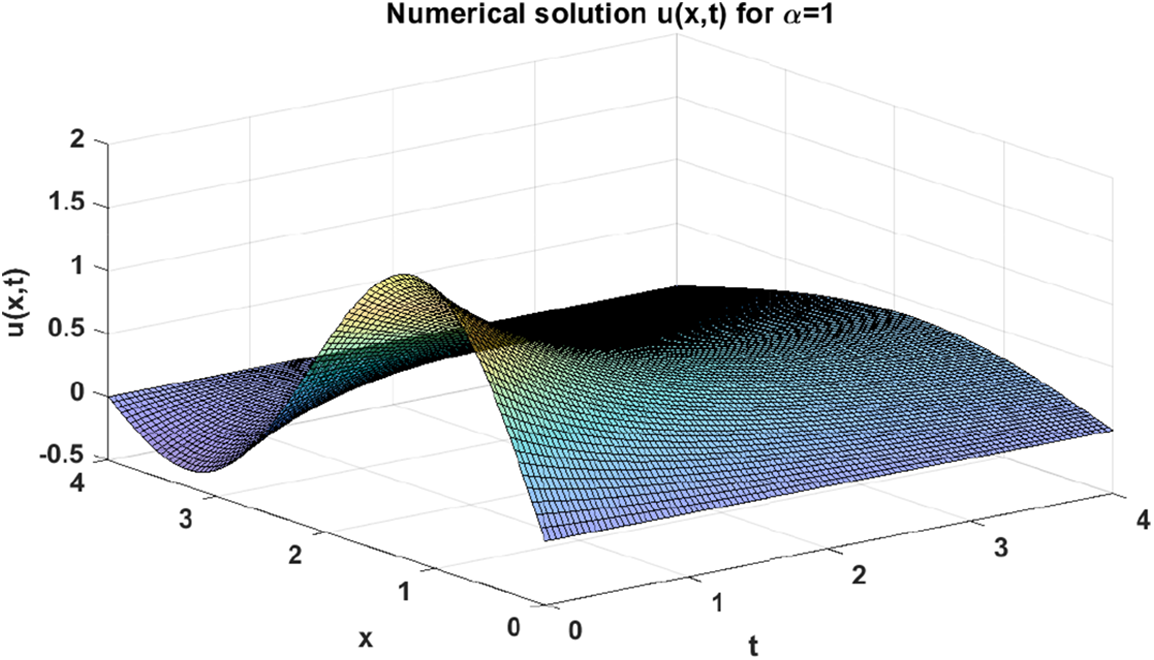
Figure 2: Numerical solution
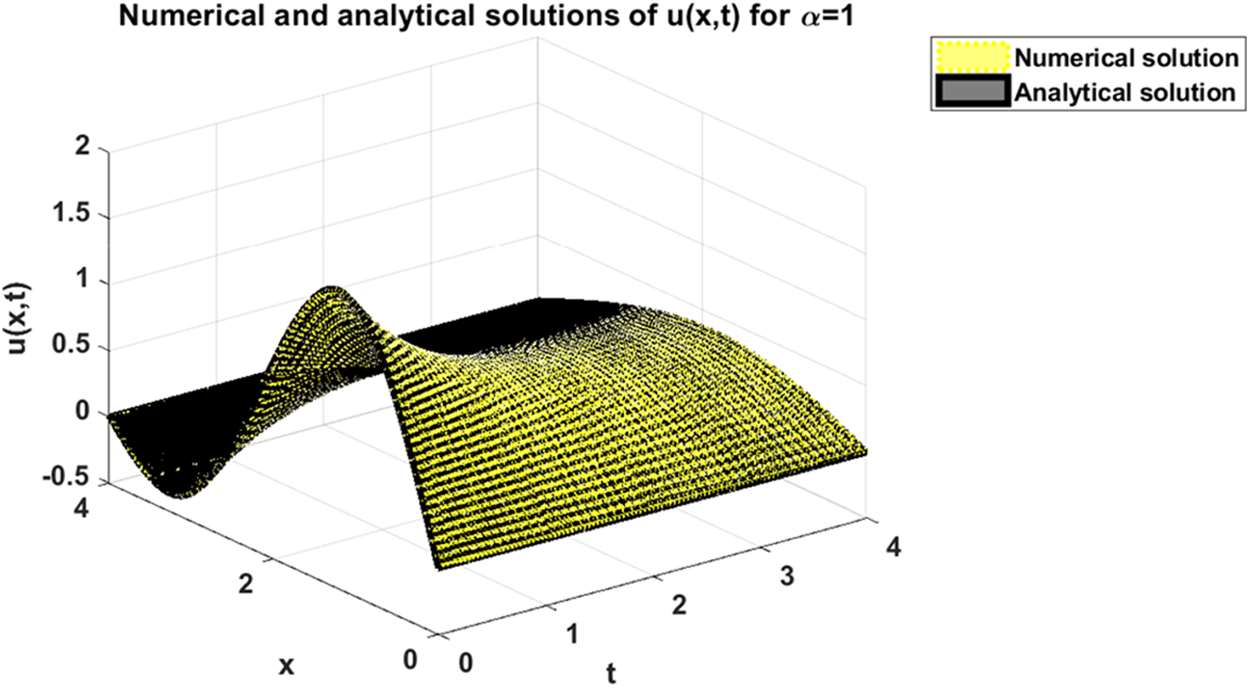
Figure 3: Comparison between numerical and analytical solutions of problem (27) when

Figure 4: Absolute value of errors between numerical and analytical solutions of problem (27) when

At this point, for the purpose of illustrating the dynamics of the numerical solution of problem (27) when, e.g.,
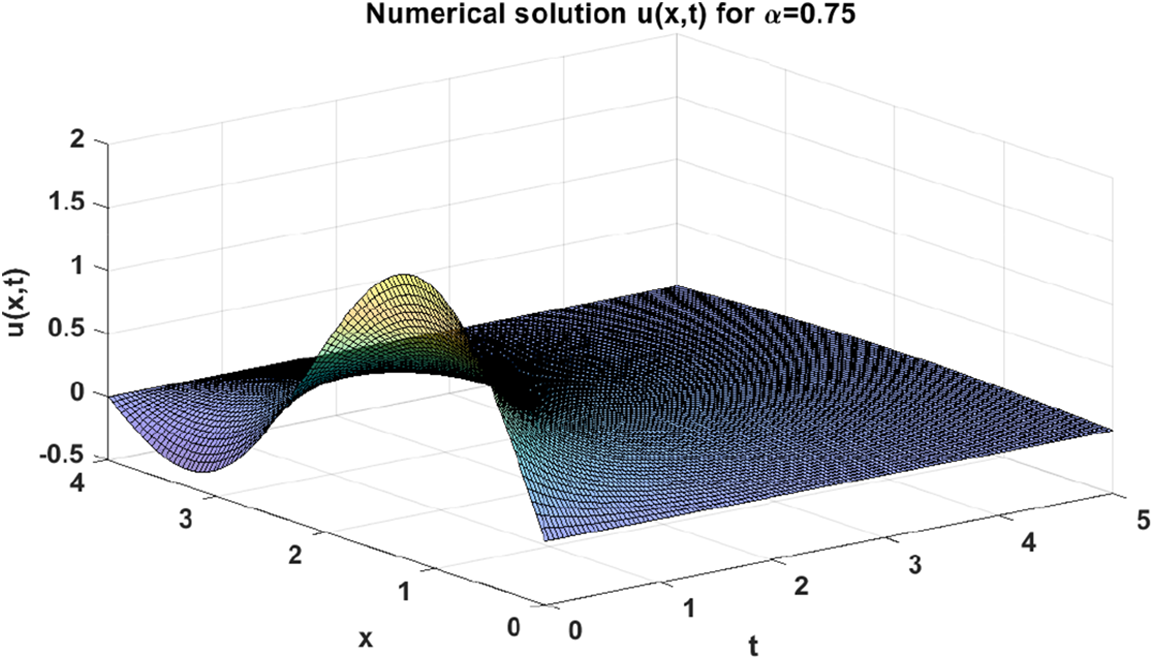
Figure 5: Numerical solution of problem (27) when

Figure 6: Dynamics of the numerical solution of problem (27) w.r.t
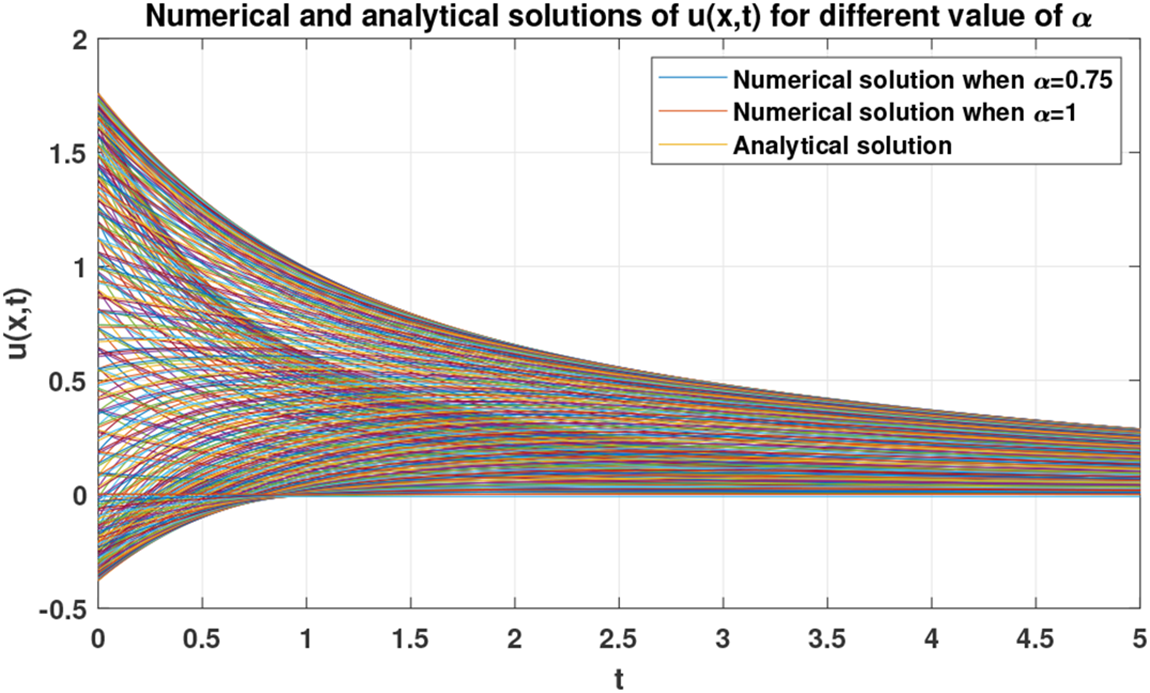
Figure 7: Dynamics of the numerical solution of problem (27) w.r.t
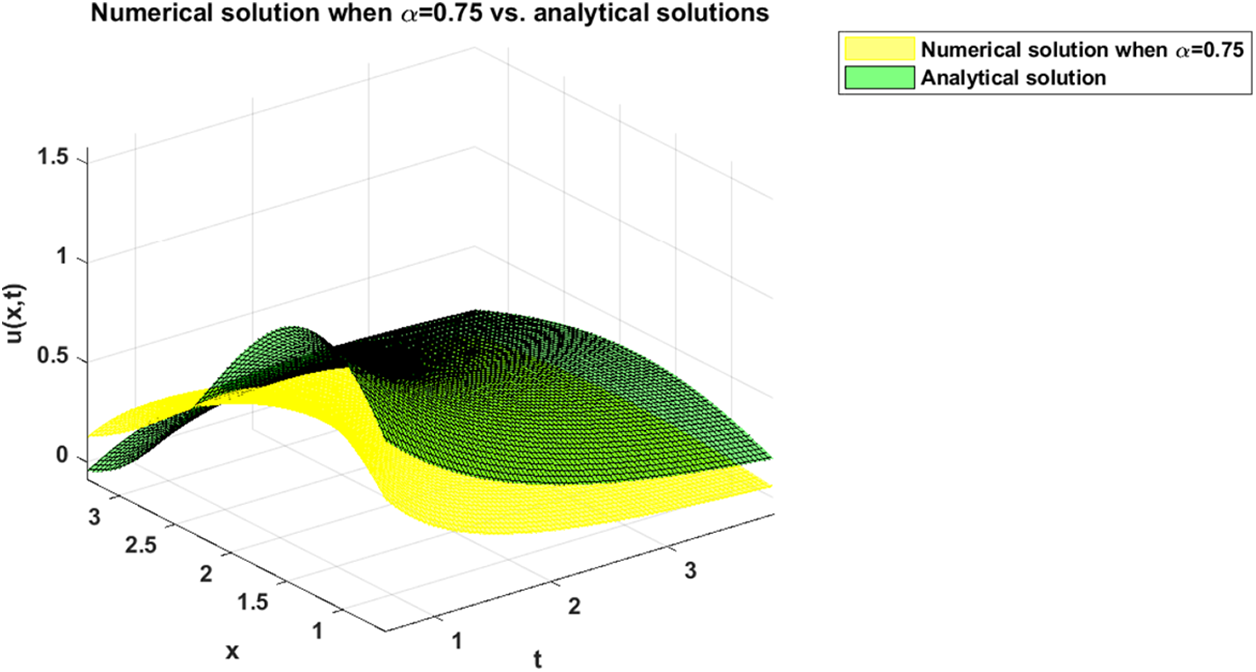
Figure 8: Comparison between numerical solution when
Example 4.2. Consider the following fractional heat conduction equation:
with boundary conditions
and with initial condition
The analytical solution of problem (29) when
The above analytical solution (28) can be plot as shown in Fig. 9. Now, when we apply on the proposed numerical approach discussed in Section 3 with letting
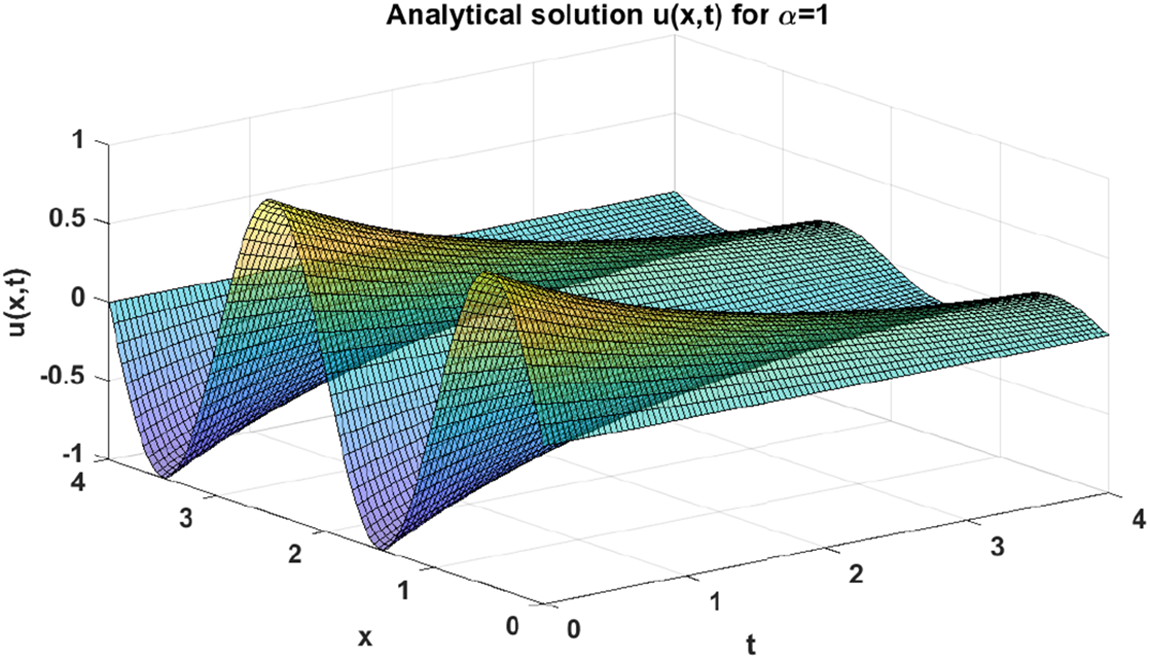
Figure 9: Analytical solution
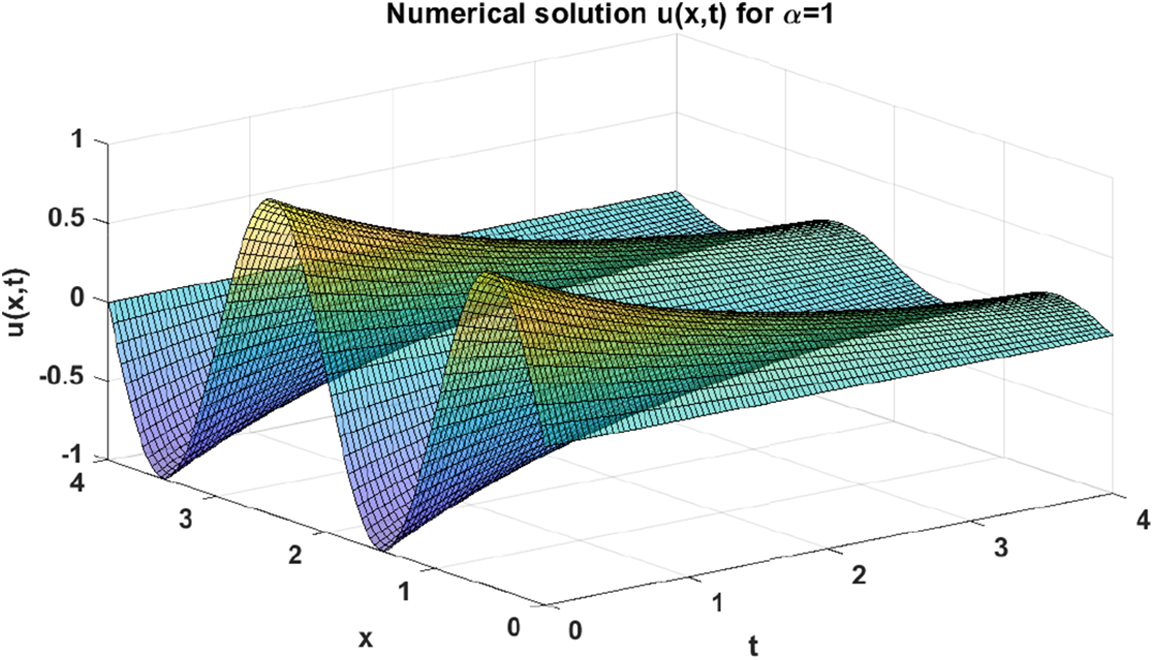
Figure 10: Numerical solution

Figure 11: Comparison between numerical and analytical solutions of problem (29) when

Figure 12: Absolute value of errors between numerical and analytical solutions of problem (29) when

With the aim of illustrating the dynamics of the numerical solution of problem (29) when, e.g.,
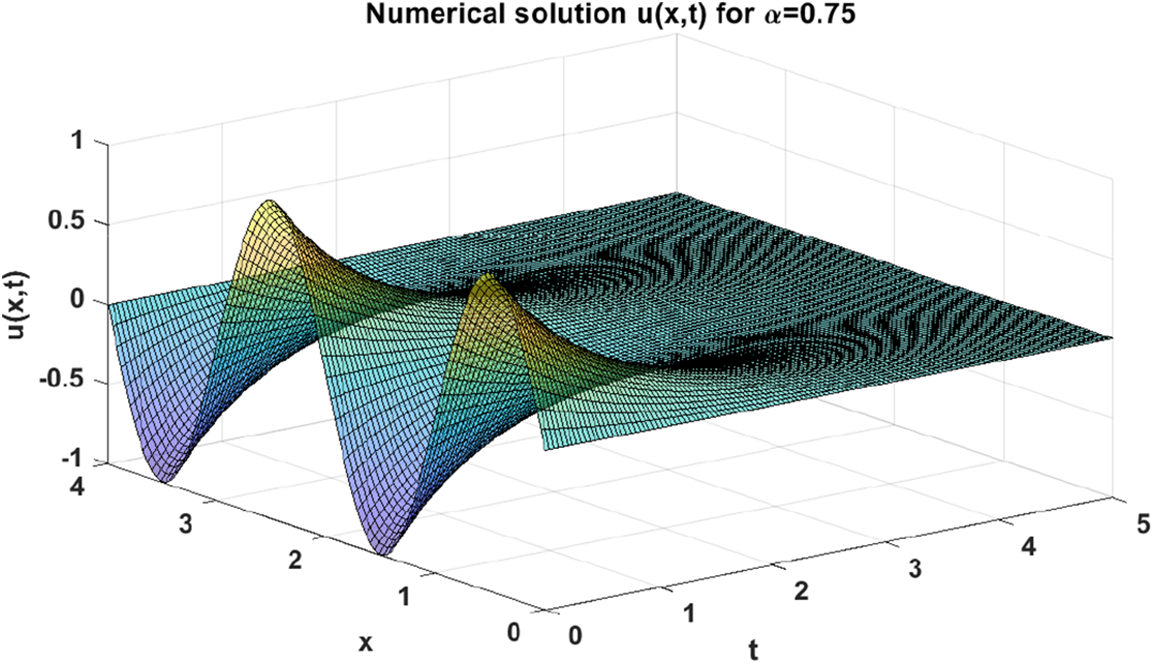
Figure 13: Numerical solution of problem (29) when
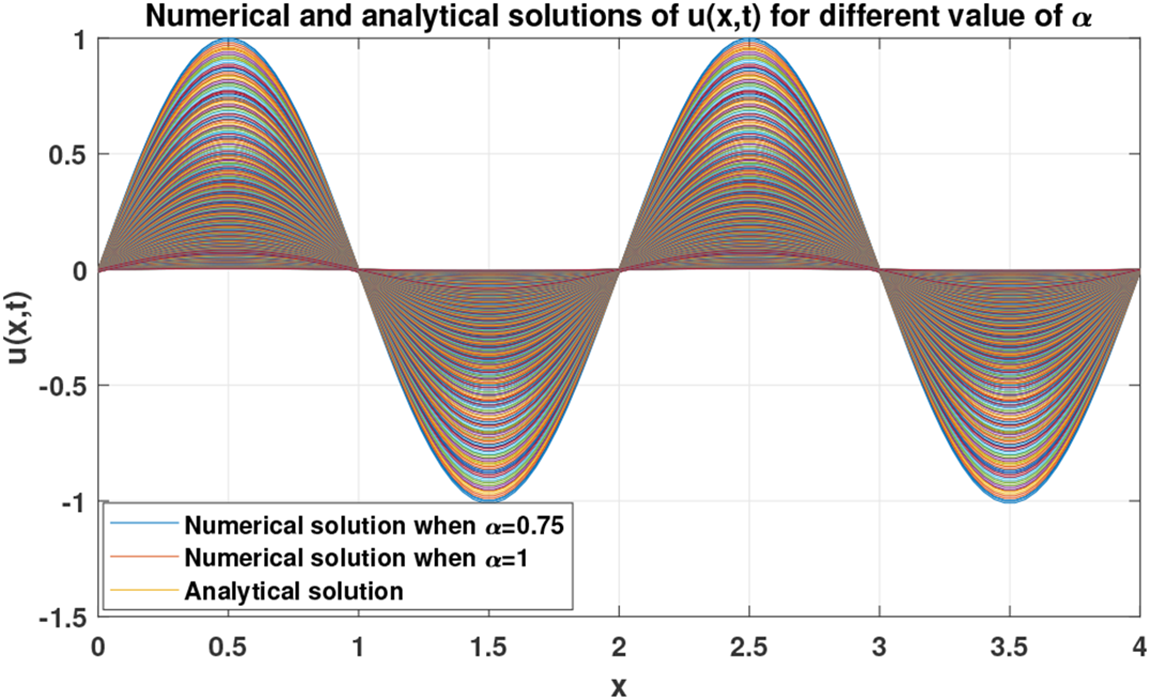
Figure 14: Dynamics of the numerical solution of problem (29) w.r.t
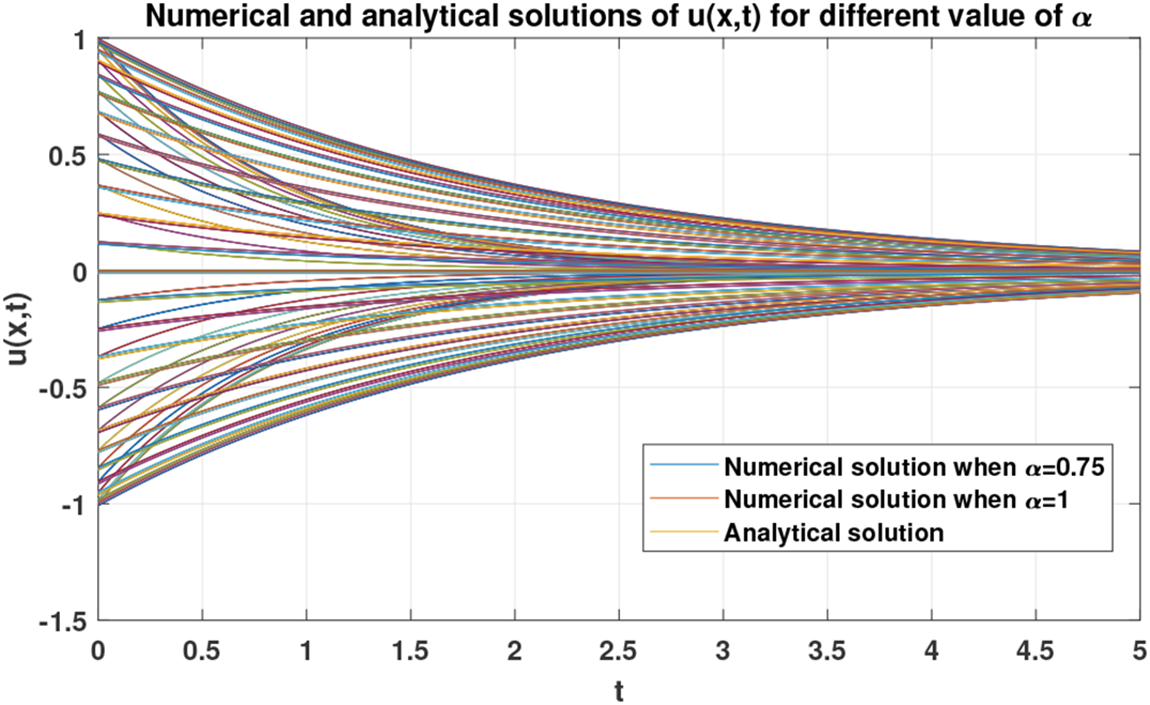
Figure 15: Dynamics of the numerical solution of problem (29) w.r.t
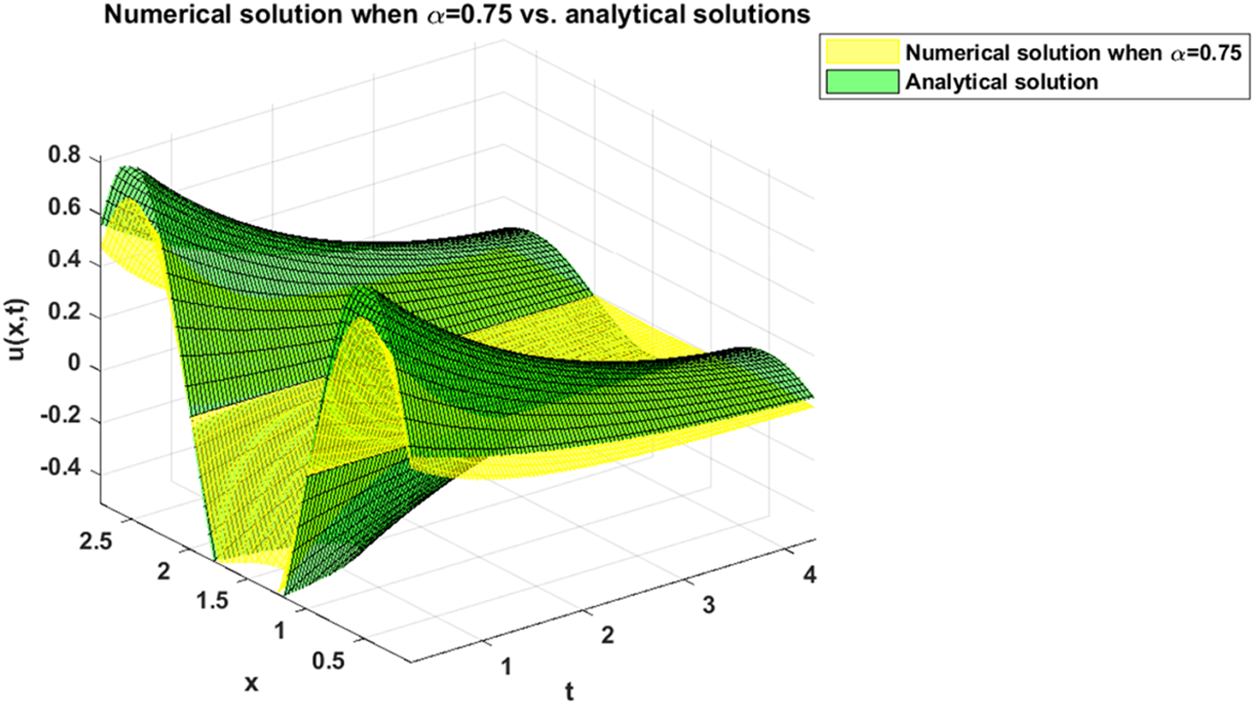
Figure 16: Comparison between numerical solution when
Based on the examples and figures presented earlier, it is evident that the proposed formula offers a reliable approximation for the heat conduction equation in the fractional-order when compared with the provided analytical values. This observation suggests that the formula holds promise for various applications, particularly those involving ordinary and partial differential equations. With this encouraging outcome, there is potential for applying the formula in numerous real-world scenarios, enabling more efficient and accurate solutions to similar problems. In particular, our future direction will be focused on addressing similar problems to ours including solving two-dimensional fractional heat conduction equation, one-dimensional fractional wave equation, two-dimensional fractional wave equation, etc.
Acknowledgement: The authors wish to express their appreciation to the reviewers for their helpful suggestions which greatly improved the presentation of this paper.
Funding Statement: The authors received no specific funding for this study.
Author Contributions: The authors confirm contribution to the paper as follows: study conception and design: Iqbal M. Batiha, Shaher Momani; data collection: Hamza S. Kanaan; analysis and interpretation of results: Iqbal M. Batiha, Iqbal H. Jebril, Mohammad Zuriqat; draft manuscript preparation: Hamza S. Kanaan, Shaher Momani. All authors reviewed the results and approved the final version of the manuscript.
Availability of Data and Materials: Data sharing is not applicable to this article as no new data were created or analyzed in this study.
Conflicts of Interest: The authors declare that they have no conflicts of interest to report regarding the present study.
References
1. He, J. (2019). A simple approach to one-dimensional convection-diffusion equation and its fractional modification for E reaction arising in rotating disk electrodes. Journal of Electroanalytical Chemistry, 854(1), 1–2. [Google Scholar]
2. Cannon, J. (1984). The one dimensional heat equation. UK: Cambridge University Press. [Google Scholar]
3. Ilic, M., Turner, I., Liu, F., Anh, V. (2010). Analytical and numerical solutions of a one dimensional fractional in space diffusion equation in a composite medium. Applied Mathematics and Computation, 216(8), 2248–2262. [Google Scholar]
4. Povstenko, Y. (2013). Fractional heat conduction in infinite one dimensional composite medium. Journal of Thermal Stresses, 36(4), 351–363. [Google Scholar]
5. Povstenko, Y. (2013). Fractional heat conduction in an infinite medium with a spherical inclusion. Entropy, 15(10), 4122–4133. [Google Scholar]
6. Jiang, X., Chen, S. (2015). Analytical and numerical solutions of time fractional anomalous thermal diffusion equation in composite medium. ZAMM Zeitschrift fur Angewandte Mathematik und Mechanik, 95(2), 156–164. [Google Scholar]
7. Zhuang, Q., Yu, B., Jiang, X. (2015). An inverse problem of parameter estimation for timefractional heat conduction in a composite medium using carbon carbon experimental data. Physica B: Condensed Matter, 456(1), 9–15. [Google Scholar]
8. Murio, D. (2008). Time fractional IHCP with Caputo fractional derivatives. Computers and Mathematics with Applications, 56(9), 2371–2381. [Google Scholar]
9. Ghazizadeh, H., Azimi, A., Maerefat, M. (2012). An inverse problem to estimate relaxation parameter and order of fractionality in fractional single phase lag heat equation. International Journal of Heat and Mass Transfer, 55(7–8), 2095–2101. [Google Scholar]
10. Yu, B., Jiang, X. (2019). Temperature prediction by a fractional heat conduction model for the bilayered spherical tissue in the hyperthermia experiment. International Journal of Heat and Mass Transfer, 145(1), 105990. [Google Scholar]
11. Dababneh, A., Sami, B., Abu Hammad, M., Zraiqat, A. (2020). A new impulsive sequential multiorders fractional differential equation with boundary conditions. Journal of Mathematical and Computational Science, 10(6), 2871–2890. [Google Scholar]
12. Bahia, G., Ouannas, A., Batiha, I., Odibat, Z. (2021). The optimal homotopy analysis method applied on nonlinear time fractional hyperbolic partial differential equations. Journal of Mathematical and Computational Science, 37(3), 2008–2022. [Google Scholar]
13. Chebana, Z., Oussaeif, T., Ouannas, A., Batiha, I. (2022). Solvability of Dirichlet problem for a fractional partial differential equation by using energy inequality and Faedo Galerkin method. Innovative Journal of Mathematics, 1(1), 34–44. [Google Scholar]
14. He, J., Ji, F. (2019). Two scale mathematics and fractional calculus for thermodynamics. Thermal Science, 23(4), 2131–2133. [Google Scholar]
15. Ahmad, H., Khan, T., Stanimirovic, P., Ahmad, I. (2020). Modified variational iteration technique for the numerical solution of fifth order KdV-type equations. Journal of Applied and Computational Mechanics, 6(1), 1220–1227. [Google Scholar]
16. Hammachukiattikul, P., Mohanapriya, A., Ganesh, A., Rajchakit, G., Govindan, V. et al. (2020). A study on fractional differential equations using the fractional Fourier transform. Advances in Difference Equations, 2020(1), 691. [Google Scholar]
17. Maitama, S. (2018). Local fractional natural Homotopy perturbation method for solving partial differential equations with local fractional derivative. Progress in Fractional Differentiation and Applications, 4(3), 219–228. [Google Scholar]
18. Zhang, J., Zhang, X., Yang, B. (2018). An approximation scheme for the time fractional convection diffusion equation. Applied Mathematics and Computation, 335(1), 305–312. [Google Scholar]
19. Agarwal, R., Sonal, J. (2018). Mathematical modeling and analysis of dynamics of cytosolic calcium ion in astrocytes using fractional calculus. Journal of Fractional Calculus and Applications, 9(2), 1–12. [Google Scholar]
20. Pitolli, F. (2020). On the numerical solution of fractional boundary value problems by a spline quasi interpolant operator. Axioms, 9(2), 61. [Google Scholar]
21. Odibat, Z., Momani, S. (2008). An algorithm for the numerical solution of differential equations of fractional order. Journal of Applied Mathematics and Informatics, 26(1), 15–27. [Google Scholar]
22. Batiha, I., Bataihah, A., Al Nana, A., Shameseddin, A., Jebril, I. et al. (2023). A numerical scheme for dealing with fractional initial value problem. ICIC Express Letters, 19(3), 763–774. [Google Scholar]
23. Batiha, I., Abubaker, A., Jebril, I., Al Shaikh, S., Matarneh, K. (2023). New algorithms for dealing with fractional initial value problems. Axioms, 12(5), 488. [Google Scholar]
24. Memon, Z., Chandio, M., Qureshi, S. (2015). On consistency, stability and convergence of a modified ordinary differential equation solver. Sindh University Research Journal, 47(4), 631–636. [Google Scholar]
25. Islam, M. (2015). Accuracy analysis of numerical solutions of initial value problems (IVP) for ordinary differential equations (ODE). IOSR Journal of Mathematics, 11(3), 18–23. [Google Scholar]
26. Pandey, P. (2018). A new computational algorithm for the solution of second order initial value problems in ordinary differential equations. Applied Mathematics and Nonlinear Sciences, 3(1), 167–174. [Google Scholar]
27. Li, X., Wang, S., Zhao, M. (2013). Two methods to solve a fractional single phase moving boundary problem. Central European Journal of Physics, 11(10), 1387–1391. [Google Scholar]
28. Batiha, I., El Khazali, R., AlSaedi, A., Momani, S. (2018). The general solution of singular fractional order linear time invariant continuous systems with regular pencils. Entropy, 20(6), 400. [Google Scholar] [PubMed]
29. Batiha, I., Alshorm, S., Ouannas, A., Momani, S., Ababneh, O. et al. (2022). Modified three point fractional formulas with Richardson extrapolation. Mathematics, 10(19), 3489. [Google Scholar]
30. Burden, R. L., Faires, J. D. (2010). Numerical analysis, 9th edition. Bosto, USA: Cengage Learning. [Google Scholar]
Cite This Article
 Copyright © 2023 The Author(s). Published by Tech Science Press.
Copyright © 2023 The Author(s). Published by Tech Science Press.This work is licensed under a Creative Commons Attribution 4.0 International License , which permits unrestricted use, distribution, and reproduction in any medium, provided the original work is properly cited.


 Submit a Paper
Submit a Paper Propose a Special lssue
Propose a Special lssue View Full Text
View Full Text Download PDF
Download PDF Downloads
Downloads
 Citation Tools
Citation Tools